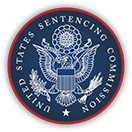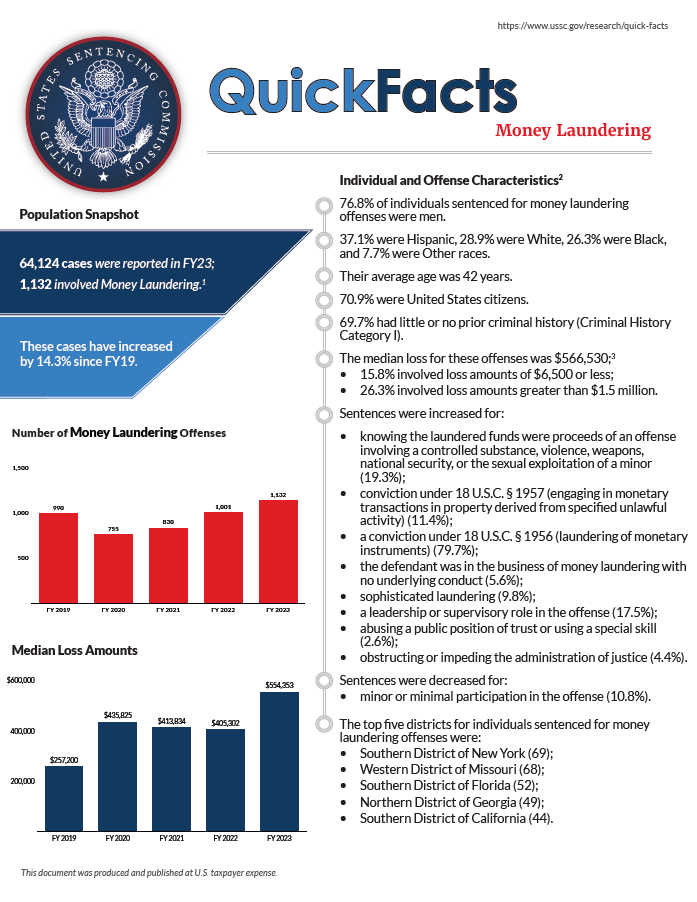Of the 61,678 cases reported to the Commission in fiscal year 2024, 1,095 involved money laundering (up 45.0% since fiscal year 2020).1,2
Click the cover for the PDF handout or learn more below.
Individual and Offense Characteristics
- 79.0% of individuals sentenced for money laundering offenses were men.
- 35.9% were Hispanic, 31.1% were White, 24.8% were Black, and 8.2% were Other races.
- Their average age was 43 years.
- 73.7% were United States citizens.
- 73.8% had little or no prior criminal history (Criminal History Category I).
- The median loss for these offenses was $526,000;3
- 0.9% involved loss amounts of $6,500 or less;
- 31.7% involved loss amounts greater than $1.5 million.
- Sentences were increased for:
- knowing the laundered funds were proceeds of an offense involving a controlled substance, violence, weapons, national security, or the sexual exploitation of a minor (16.0%);
- conviction under 18 U.S.C. § 1957 (engaging in monetary transactions in property derived from specified unlawful activity) (13.6%);
- a conviction under 18 U.S.C. § 1956 (laundering of monetary instruments) (77.5%);
- the defendant was in the business of money laundering with no underlying conduct (5.7%);
- sophisticated laundering (11.2%);
- a leadership or supervisory role in the offense (17.4%);
- abusing a public position of trust or using a special skill (2.8%);
- obstructing or impeding the administration of justice (4.5%).
- Sentences were decreased for:
- minor or minimal participation in the offense (9.9%).
- minor or minimal participation in the offense (9.9%).
- The top five districts for money laundering offenses were:
- Southern District of California (62);
- Southern District of New York (56);
- Southern District of Texas (47);
- Eastern District of Texas (45);
- District of Massachusetts (41).
Punishment
- The average sentence length for individuals sentenced for money laundering offenses was 62 months.
- 89.8% were sentenced to prison.
- 25.6% were convicted of an offense carrying a mandatory minimum penalty; 54.4% of those individuals were relieved of that penalty.
Sentences Relative to the Guideline Range
- 55.4% of sentences for money laundering were under the Guidelines Manual.
- 20.9% were within the guideline range.
- 27.3% were substantial assistance departures.
- The average sentence reduction was 67.2%.
- The average sentence reduction was 67.2%.
- 1.2% were Early Disposition Program (EDP) departures.4
- The average sentence reduction was 55.9%.
- The average sentence reduction was 55.9%.
- 6.0% were some other downward departure.
- The average sentence reduction was 50.6%.
- The average sentence reduction was 50.6%.
- 20.9% were within the guideline range.
- 44.6% of sentences for money laundering were variances.
- 43.4% were downward variances.
- The average sentence reduction was 48.8%.
- The average sentence reduction was 48.8%.
- 1.2% were upward variances.
- The average sentence increase was 45.0%.
- 43.4% were downward variances.
- The average guideline minimum increased and average sentence imposed have fluctuated over the past five years.
- The average guideline minimum increased and decreased throughout the fiscal years. The average guideline minimum was 107 months in fiscal year 2020 and 108 months in fiscal year 2024.
- The average sentence imposed increased and decreased throughout the fiscal years. The average sentence was 64 months in fiscal year 2020 and 62 months in fiscal year 2024.
- The average guideline minimum increased and decreased throughout the fiscal years. The average guideline minimum was 107 months in fiscal year 2020 and 108 months in fiscal year 2024.
1 Money Laundering offenses include cases in which the individual was sentenced under §2S1.1 (Laundering of Monetary Instruments; Engaging in Monetary Transactions in Property Derived from Unlawful Activity).
2 Cases with incomplete sentencing information were excluded from the analysis.
3 The Loss Table was amended effective November 1, 2001 and November 1, 2015.
4 “Early Disposition Program” (or EDP) departures are departures where the government sought a sentence below the guideline range because the defendant participated in the government’s Early Disposition Program, through which cases are resolved in an expedited manner. See USSG §5K3.1.
SOURCE: United States Sentencing Commission, FY 2020 through FY 2024 Datafiles, USSCFY20-USSCFY24.

